Performances can be scary. Can you remember how you felt as a music student walking onto a stage for the first time? Do you remember your hands shaking as you played your first note?
As teachers we can help our students feel less nervous about performing, and boost their confidence, whether they’re playing in a recital, a competition, or an exam.
A music performance can be a nerve-wracking experience.
Can you remember how you felt as a music student walking onto a stage for the first time? Do you remember your hands shaking as you played your first note?
As teachers, we can help our students feel less nervous and more excited about performing, whether they’re preparing for a recital, a competition, or an exam.
Table Of Contents:
About three weeks before the performance, record your students playing. This can just be on your phone or iPad (nothing fancy needed). You could even just record the sound onto the digital piano or keyboard. As soon as you press record, the nerves will kick in.
When they’ve recorded their piece, have them watch it or listen to it.
This is beneficial in several ways:
Related: 5 Strategies for Overcoming Performance Anxiety
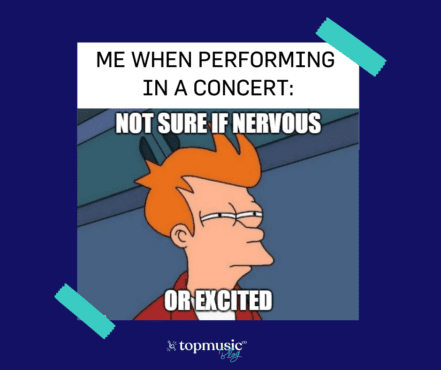
In their lessons, students get used to you sitting in a certain place. If you sit on their right, they get used to feeling a presence on their right as they play.
We want them to feel slightly uncomfortable (not in a bad way!)
If possible, sit to the left of the piano. Just this small change will feel different. Your student will possibly even comment on how it feels weird having you on the different side!
If your room allows, sit at the back of the room. This again will provide a different feeling for your student as they’re possibly not used to playing with someone sitting behind them. Again, they’ll probably comment on how weird it feels to have you sitting behind them! This is good – we want them to be aware of how they’re feeling as this will help when it comes to the performance.
No audience is ever completely silent. People shuffle in their seats. They cough, they sniff, hey rustle their programs.
In an exam setting, examiners write while the student performs. We’ve even known examiners to talk to themselves under their breath during exam performances.
While sitting in a different place, you could make these quiet audience and examiner sounds, telling your student to keep playing and to not be distracted by anything. Obviously, this is up to the teacher’s discretion – you know if certain students need practice in ignoring any sounds around them!
More often than not, students only ever play in front of you (their teacher) and possibly their parents (and sometimes not even them!)
Going from performing just to their teacher to a big crowd full of people they’ve never met before can feel overwhelming. While some students thrive on this experience and feel the buzz of performing to anyone, for others, this can be a really daunting event.
Performing for a small group in the lead-up to a performance can help a student become used to playing in front of others. This group could be…
Related: Discover How To Battle Through Performance Anxiety With Artist Matthew Xiong
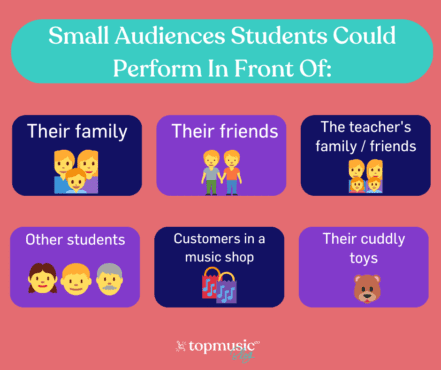
If a student is preparing for a performance in an exam setting, they’re going to be playing in front of one person, who looks officious and important. To get your students used to this feeling, you could ask one of your friends or family members to pose as an examiner. It could go a little something like this…
We know one teacher who asked an adult student to be a fake examiner for younger students who were preparing for grade exams. As he had sat exams himself, he took the job very seriously, spoke with an “examiner voice”, thanked the student after each piece, exercise and scale, and made detailed notes on his paper as they played. When the student had finished playing everything the adult student held up his ‘notes’ to reveal that he’d just been drawing a funny picture while they played.
When the students were asked about their pretend examiner experience they said they felt nervous playing in front of him. They wanted to play the best they could to impress him as they’d seen him play in studio recitals and thought he’d actually be marking their performances.
Side note: the teacher also told us that the students who had this pretend examiner experience performed brilliantly in their exams as they imagined they were playing to the fake examiner who was drawing a picture!
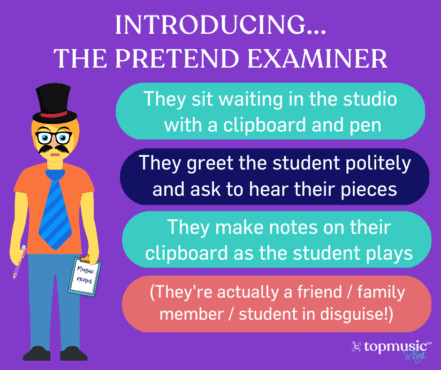
Sometimes it’s possible to perform in the concert or recital venue before the actual event.
This is great as it prepares the students for how the instrument feels to play, how it sounds in the venue, and how they feel in a different setting.
If you can, you can even get your students to take their lesson before the event in the actual performance space. Alternatively, you can organize a day for students to drop in and experience the venue.
As this isn’t always feasible, another suggestion is to have performers arrive one hour prior to the audience so they can have a quick practice before the main event.
Related: How To Tackle Piano Performance Anxiety
In the last lesson before the performance, students need a confidence boost.
They’ve worked hard learning the piece, they’ve put the practice in, and now it’s time for the performance.
Chances are they’re feeling nervous about the event, so one of the last things they need in the lead-up is to focus on the things they can’t do or the mistakes they’re making. Instead, they need a boost.
Use this last lesson to point out all the things they do well and compliment them on their playing. This means that when they walk onto the stage or into the examination room they have your positive words in their head making them feel confident and ready to play.
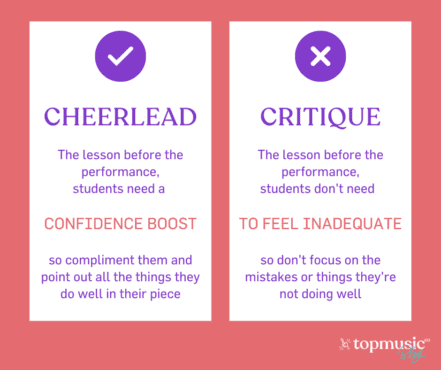
Noa Kageyama, creator of The Bulletproof Musician blog and Performance Psychologist at Julliard has a fantastic course to help teachers guide their students in deliberate practice, ensuring their practice is preparing them for being able to perform. He talks through the research behind productive practice and shares the best approach to making sure that you can play your piece correctly the first time – exactly what we have to do in performances!
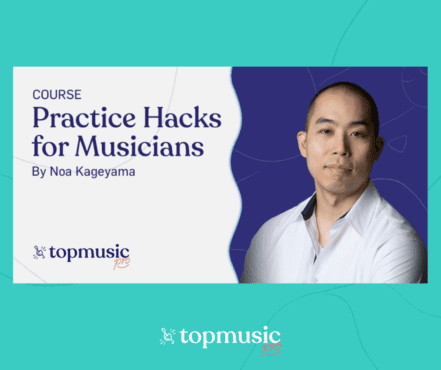
“Practice Hacks for Musicians by Noa Kageyama” is available for Studio and Evolution Members of TopMusicPro.
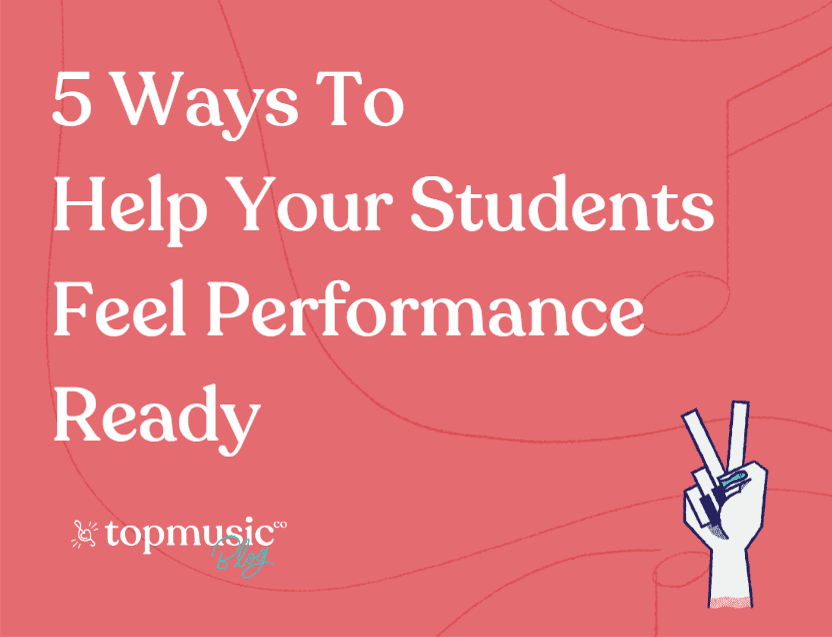
Sherri Guerra says:
Thank you, Ms. Wilson, for these great ideas for reducing performance jitters and how to prepare our students to play well. With spring recitals coming up soon, these were good reminders of how to boost a student’s confidence, and also how to have them make an honest self-appraisal of progress made (video a mock ‘performance’).
Vanessa Munns says:
I record my students a lot, and the record button on phone is called “the red button of death!” It helps to talk to them on a regular basis, and talk about your own issues when performing. I remember doing a duet with a student once, in front of a large audience, and my hands were shaking so badly I even pointed it out to my student. Who knows how this is going to go? But it was a perfect performance once the first notes got played!
ted ryden says:
Thanks for the good ideas on helping students get ready for performing for other people! Even the simple changing of teacher location on the student’s right or left should help the student to make adjustments to the conditions.